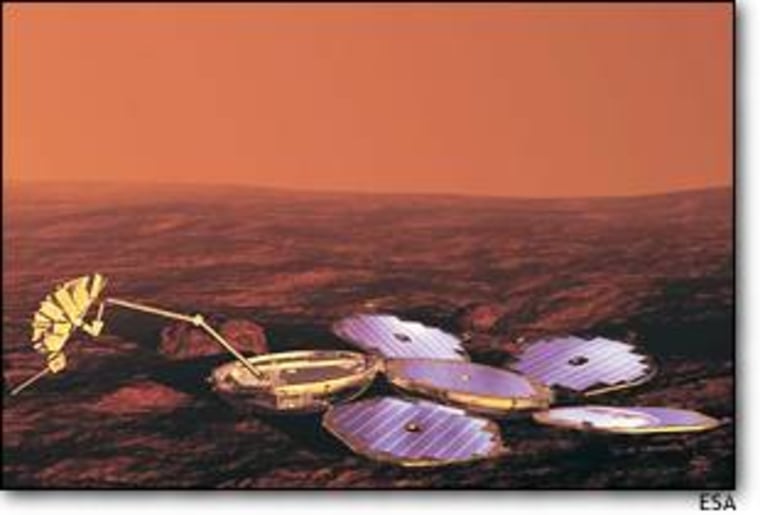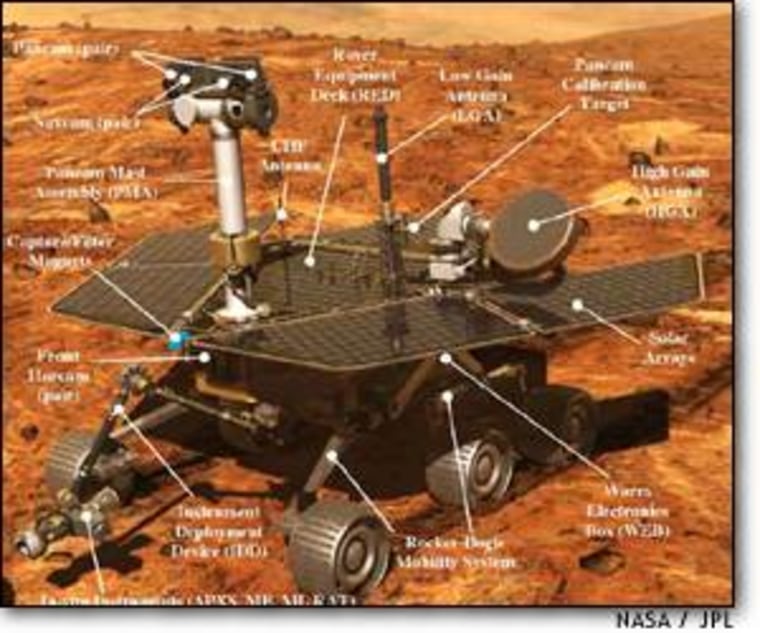Europe’s Mars Express, toting the British-built Beagle 2 lander, remains set for launch June 2 and is to be the opening volley in a salvo of Mars robotic spacecraft heading outward to that compelling world during the coming weeks.
All is ready for the European Space Agency’s (ESA) Mars Express to blast off from the Baikonur Cosmodrome in Kazakhstan riding atop a commercially-procured Starsem Soyuz rocket with a Fregat upper stage.
Meanwhile, as Mars Express awaits departure, NASA’s dual Mars Exploration Rovers are being prepped for sendoff. Now simply labeled MER-A and MER-B, the first craft is slated for dispatch from Florida’s Space Coast no earlier than June 8. The second rover is to roar skyward on June 25.
Officials say this international squadron of Red Planet robots will open a new chapter in Mars inquiry.
Probing for water and life
The Mars Express orbiter is to haul along a suite of scientific instruments.
Circling Mars the spacecraft is equipped to:
- Conduct global high-resolution imaging.
- Carry out planet-wide mineralogical mapping.
- Chart global atmospheric circulation and map atmospheric composition.
- Radar sound the subsurface of Mars.
- Study surface-atmosphere interactions.
- Survey the relationship between the planet’s atmosphere with the interplanetary environment.
While ESA’s Mars Express swings about Mars, the United Kingdom’s Beagle 2 is set to become the first lander since NASA’s two Viking probes in the 1970s to expressly look for indications of past or present life.
No other Mars probe planned so far is centrally focused on making measurements with exobiology in mind, Beagle 2 scientists say.
Beagle 2 is to touch down Dec. 24 at Isidis Planitia, a flat basin on Mars with ground water ice possibly lurking a few feet below surface.
Meanwhile, NASA’s two look-alike rovers are tasked to eke out the history of climate and water at two sites on Mars where conditions may once have been favorable to life.
The identical twins are being lofted individually and targeted to land in different parts of Mars: Meridiani Planum, an area thought to be rich in hematite, possibly a byproduct of ancient hot springs; and Gusev crater, perhaps an ancient lakebed.
Each Mars Exploration Rover is designed to parachute to an airbag-cushioned touch down. The first robot is to reach Mars on Jan. 4, 2004, followed by the second on Jan. 25.
Bon voyage
While the liftoff of Mars Express is near at hand, there’s still a long road ahead, said Colin Pillinger, leader of the Beagle 2 team. He is head of Planetary and Space Sciences Research Institute at the Open University in Milton Keynes, England.
Pillinger said the recently released Mars Global Surveyor snapshot of Earth and our planet’s moon from Mars is a kind of poignant image of what is being left behind.
“Beagle 2 leaves behind the best team of scientists and engineers imaginable,” Pillinger told SPACE.com. “It carries with it our hopes for the future.”

Still to come is the crossing of the interplanetary void and a very risky journey to the surface of Mars, Pillinger said. “It’s too early to celebrate yet but we will wish our tiny craft bon voyage on Monday evening at the launch party.”
The UK’s Beagle 2 Mars Probe was built by Astrium, Stevenage.
Beagle 2 will be ejected from the Mars Express orbiter and fall onto the martian surface following parachute braking and inflation of gas-filled landing bags. The craft’s landing weight is a mere 66-pounds (30-kilograms).
Once down on martian terrain, the probe stays put. It makes use of a robotic arm to reach about its landing spot.
Strike out or home run?
“The Beagle is not a toy. It’s not a dog. Beagle is a scientific spacecraft with some of the highest quality scientific instruments that are ever to be placed on a planet,” said Everett Gibson, a space scientist at NASA’s Johnson Space Center in Houston.
Selected by ESA, Gibson is the only U.S. interdisciplinary scientist to work with the Beagle 2 lander for the Mars Express mission.
“Beagle 2 has the highest percentage of its mass devoted to science of any planetary probe that has been launched in the past or even planned,” Gibson told SPACE.com. “It’s going to be fun ... to actually get a spacecraft on the surface that has the promise of relaying important information on potential biogenic signatures on Mars.”
Those biogenic signatures could help unravel the story of life on Mars.
“We could strike out. But we’re hoping to hit a home run,” Gibson said.
Gibson said that the compact Beagle 2 should be a harbinger of things to come.
“Every orbiter that goes to Mars or other type body could carry a payload of the Beagle type,” Gibson said. “Why not put a Beagle, or sons of Beagle, on every orbiter going to Mars in the future?”
Life on Mars: Could be old news
“Beagle 2 is a miracle of mind over matter ... shooting for Mars by enormous will power, despite the infinitesimal budget that dictates its tiny size and payload. I hope it gets to Mars safely and realizes its high ambitions,” said Gilbert Levin, the experimenter for the Viking Labeled Release experiment. He is now chief executive officer for Spherix Incorporated in Beltsville, Md.
Levin remains convinced that the Viking Labeled Release experiment did detect microbial life in the soil of Mars — not some strong oxidant that mimicked the signature of alive and well biology.
Levin said he is somewhat puzzled by those who claim Beagle 2 is a Mars life detection mission. Equipment carried by the lander, he feels, will not furnish unambiguous proof of living organisms on the Red Planet.
“However, I do eagerly await the Beagle 2 findings,” Levin added.
“I feel certain no strong oxidants will be found on the surface of Mars, hopefully dealing a final blow to that discredited, but persisting theory. Also, I believe the results obtained by Beagle 2 will establish that water occurs in liquid form on the surface of Mars. Both results will add to the growing arguments supporting a biological interpretation of the 1976 Viking Labeled Release data,” he said.
Scientific rationale
Anxiously awaiting the launch of the next batch of Mars probes is Bruce Jakosky, a Mars expert at the University of Colorado in Boulder. He senses, however, that Mars exploration actually passed a major milestone about a half-dozen years ago.
“The real turning point came with the widespread acceptance of the current scientific rationale for continuing to explore Mars,” Jakosky said. “This approach centers on understanding Mars as an integrated system, including the current climate, the evolution of the atmosphere and surface, and the potential for life,” he said.

Jakosky said this Mars exploration theme is embedded in the entire series of missions that have already flown, failed to reach the target, are flying now, or will fly over the next decade.
This includes the Mars Pathfinder, Mars Global Surveyor, Mars Odyssey, and Japan’s Nozomi mission still en route.
Then there’s the back-to-back failure of NASA’s Mars Climate Orbiter and the Mars Polar Lander, right up to the up-and-coming missions — Europe’s Mars Express/Beagle 2 and NASA’s dual Mars Exploration Rovers.
This armada of Mars missions is to be joined by NASA’s Mars Reconnaissance Orbiter in 2005 and the Mars Science Laboratory (also termed Mars Smart Lander at one time) in 2009.
“I don’t really see us as being at a turning point in exploring Mars. However, each mission represents an important milestone in that exploration,” Jakosky told SPACE.com.
